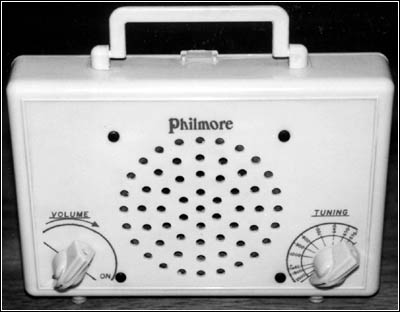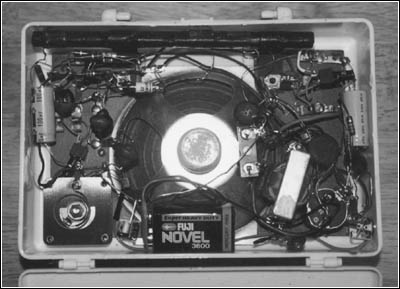Of Old Radios And Related Items--Published Monthly
The Philmore TR201 Then and Now
BY HERB PARSONS
Web Edition
Many radio collectors have been introduced to the hobby by building kit radios. Often, the first kit radio or home brew was scrapped for parts. Then in later years, there is an urge to find that first or favorite radio again. Herb Parsons tells us about his experience. (Editor)
The Philmore TR201, shown in Figures 1 and 2, is a radio that has always fascinated me. It was my first radio kit, which, when completed, was a portable that I could take out and show off to my family and friends.
I was 12 years old in early 1957 when I got my mother to take me into Boston. We usually went to the original Radio Shack at the end of Washington Street or to Lafayette Radio on Federal Street, but this time I wanted to visit a new place. I had heard about some radio shops near Scollay Square. They were similar to those found on Radio Row many years ago in New York. In one of those shops I found the TR201 kit from Philmore and couldn't go home without it.
Then -- Building and Adjusting
The next few days were spent following the step-by-step instructions to build the 2-transistor TR201. It was a pleasure to build. There was plenty of room for components, and the instructions were very clear and precise. However, I remember being disappointed when I first turned it on. Nothing but squeals and whistles emanated from the speaker.

Figure 1. This Philmore Model TR201 uses two transistors in a reflex circuit for "multitransistor" performance.

Figure 2. One look at the Philmore's "innards," and it is obvious that this is a kit radio.
Nevertheless, the instructions had several remedies if this condition arose. These consisted of changing several resistor values and reversing connections on the three RF coils. After experimenting with these remedies to "cool" the RF section a bit, I couldn't believe the performance of this set, with only two transistors! It tuned in most of the Boston stations and most with ample volume. I finally had a working portable radio! That radio served me well for quite a few years at home, on picnics and at the beach.
Now -- Reconstructing the Past
Somewhere along the way, my TR201 got scrapped for parts. About 25 years later when I started collecting antique radios. I often wondered if I could ever find one of these sets. Over the last couple of years I have submitted want ads in A.R.C. looking for one. Then, last year, I finally got a response. And what a beauty it turned out to be!
The set was in excellent condition and was complete with the original instructions. After a cleaning and some paint touch-up, it looked like a new set. Examining the inside, I found that all components were there and wired properly. I fired it up. Again I heard the familiar squeals and whistles. I repeated the steps I went through many years ago and also replaced the first transistor. To my delight, this TR201 is performing just as mine did many years ago.
This set still amazes me today. The reflex circuit allows the first transistor to act as two by assigning double duty to it. The circuit used is quite unique. This radio tunes in most of the strong local stations with ample speaker volume and requires no external antenna!
If anyone would like a copy of the schematic/instructions, write me. I am so glad I was able to obtain one of these sets. Thanks to Mr. Marvin Hess for responding to my A.R.C. ad. This set has brought back many memories.
(Herb Parsons, 5 Surrey Lane, Peabody, MA 01960-2027)
Herb Parsons has tinkered with radios since childhood when he began with crystal sets and moved on to kits and early transistor sets. In his early adulthood, he had a radio-TV repair business for about five years. Around 1980, a copy of "Antique Radio Gazette" alerted him to the existence of serious radio collecting. Since then his collection has grown to over 100 sets, and both their physical and electrical restoration continue to be a pleasure.
| [Free Sample] [Books, etc., For Sale] [Subscribe to A.R.C./Renew] [Classified Ads] [Auction Prices] [Event Calendar] [Links] [Home] [Issue Archives] [Book Reviews] [Subscription Information] [A.R.C. FAQ] URL = http://www.antiqueradio.com/Sep03_Parsons_Philmore.html Copyright © 1996-2003 by John V. Terrey - For personal use only. Last revised: October 10, 2003. For Customer Assistance please contact ARC@antiqueradio.com or call (866) 371-0512 Pages designed/maintained by Wayward Fluffy Publications
Antique Radio Classified |